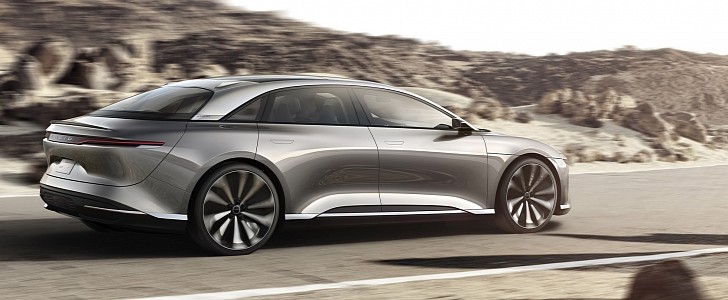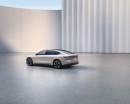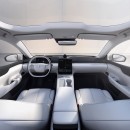After talking about how Rivian and Lucid will change the landscape in the electric vehicle market, I realized that there’s something even more important to discuss. Yes, you will not expect great things related to EVs solely from Tesla anymore. That’s a fact. However, the 520-mile (837-kilometer) range presented by the Lucid Air goes even further: it matches what combustion-engined vehicles did best. Traveling that far is not an ICE privilege anymore.
Lucid was careful to take that even further by giving its vehicles the highest voltage of any EV currently on the market. The 924V with which the Air works is a concern when it comes to crashes and first responders’ safety, but it makes it deliver the fastest charging speed of any electric vehicle available so far.
The company informs that you can recover up to 20 miles (32 km) per minute of range if you use fast chargers that are powerful enough to deliver 350 kW of charging speed. Considering that this high rate of range recovery is not constant, Lucid informs that you can get up to 300 miles (483 km) of range back in only 20 minutes, which means it would get 15 miles (24 km) of range per minute. That’s still very impressive, and it may be completely unnecessary thanks to the range the Air offers.
Very few people in the world would drive a car for more than 500 miles (805 km) on a single day. The vast majority who doesn’t do that could travel 400 miles (644 km) and still have a reserve. That means they could plug their Lucid Airs into a low-speed power outlet and allow the battery pack to charge as it really likes: with no rush. You could do that in your parking spot. This is something no combustion-engined vehicle allows. After such a trip, you’d inevitably have to stop at a fuel station.
To be fair, NIO had already done that when it presented its battery-swapping system. With it, you can drop a battery pack with a low charge for a fully charged unit in 3 to 6 minutes. In other words, you could get three battery packs in 18 minutes, in the worst-case scenario, or six in the best.
The smallest NIO battery pack delivers 70 kWh and a range of 430 km (267 mi) on the EC6. The more aerodynamic ET7 promised to achieve more than 500 km (311 mi) with it, although we have no idea what it could deliver under WLTP or EPA cycles. Spending 18 minutes for battery swaps in the worst-case scenario means that an ET7 could travel in a day would be 1,500 km (932 mi).
It is worth remembering that the company presented its biggest battery pack in November 2020 with 100 kWh. With it, an EC6 would be able to travel 615 km (382 mi) under the NEDC cycle. NIO also promised a 150-kWh solid-state battery pack for 2022.
The issue is that the company only sells its vehicles in two countries: China and Norway. Germany will join them in 2022, but there’s no word about when it would also be available in the U.S. Another problem is that it would need enough battery swapping stations for long trips to be completed. The Lucid Air’s 520-mile range does not need them.
What Lucid (and NIO) have presented is a world in which people can make plans of traveling really far with their EVs. A universe in which range anxiety is just an anecdote of the past, which kills the primary advantage ICE vehicles have apart from price. Both Lucid and NIO want to sell less expensive cars with their technologies. When that happens – and it seems to be pretty close – people will stop missing the range diesel engines can deliver.
The company informs that you can recover up to 20 miles (32 km) per minute of range if you use fast chargers that are powerful enough to deliver 350 kW of charging speed. Considering that this high rate of range recovery is not constant, Lucid informs that you can get up to 300 miles (483 km) of range back in only 20 minutes, which means it would get 15 miles (24 km) of range per minute. That’s still very impressive, and it may be completely unnecessary thanks to the range the Air offers.
Very few people in the world would drive a car for more than 500 miles (805 km) on a single day. The vast majority who doesn’t do that could travel 400 miles (644 km) and still have a reserve. That means they could plug their Lucid Airs into a low-speed power outlet and allow the battery pack to charge as it really likes: with no rush. You could do that in your parking spot. This is something no combustion-engined vehicle allows. After such a trip, you’d inevitably have to stop at a fuel station.
To be fair, NIO had already done that when it presented its battery-swapping system. With it, you can drop a battery pack with a low charge for a fully charged unit in 3 to 6 minutes. In other words, you could get three battery packs in 18 minutes, in the worst-case scenario, or six in the best.
The smallest NIO battery pack delivers 70 kWh and a range of 430 km (267 mi) on the EC6. The more aerodynamic ET7 promised to achieve more than 500 km (311 mi) with it, although we have no idea what it could deliver under WLTP or EPA cycles. Spending 18 minutes for battery swaps in the worst-case scenario means that an ET7 could travel in a day would be 1,500 km (932 mi).
It is worth remembering that the company presented its biggest battery pack in November 2020 with 100 kWh. With it, an EC6 would be able to travel 615 km (382 mi) under the NEDC cycle. NIO also promised a 150-kWh solid-state battery pack for 2022.
The issue is that the company only sells its vehicles in two countries: China and Norway. Germany will join them in 2022, but there’s no word about when it would also be available in the U.S. Another problem is that it would need enough battery swapping stations for long trips to be completed. The Lucid Air’s 520-mile range does not need them.
What Lucid (and NIO) have presented is a world in which people can make plans of traveling really far with their EVs. A universe in which range anxiety is just an anecdote of the past, which kills the primary advantage ICE vehicles have apart from price. Both Lucid and NIO want to sell less expensive cars with their technologies. When that happens – and it seems to be pretty close – people will stop missing the range diesel engines can deliver.










































































